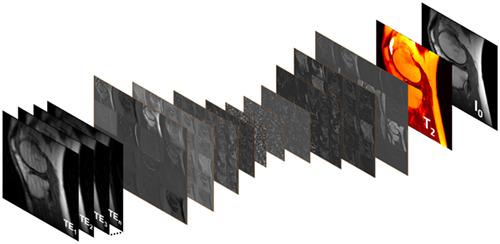当前位置:
X-MOL 学术
›
NMR Biomed.
›
论文详情
Our official English website, www.x-mol.net, welcomes your feedback! (Note: you will need to create a separate account there.)
Rapid MR relaxometry using deep learning: An overview of current techniques and emerging trends
NMR in Biomedicine ( IF 2.9 ) Pub Date : 2020-10-15 , DOI: 10.1002/nbm.4416 Li Feng 1 , Dan Ma 2 , Fang Liu 3
NMR in Biomedicine ( IF 2.9 ) Pub Date : 2020-10-15 , DOI: 10.1002/nbm.4416 Li Feng 1 , Dan Ma 2 , Fang Liu 3
Affiliation

|
Quantitative mapping of MR tissue parameters such as the spin-lattice relaxation time (T1), the spin-spin relaxation time (T2), and the spin-lattice relaxation in the rotating frame (T1ρ), referred to as MR relaxometry in general, has demonstrated improved assessment in a wide range of clinical applications. Compared with conventional contrast-weighted (eg T1-, T2-, or T1ρ-weighted) MRI, MR relaxometry provides increased sensitivity to pathologies and delivers important information that can be more specific to tissue composition and microenvironment. The rise of deep learning in the past several years has been revolutionizing many aspects of MRI research, including image reconstruction, image analysis, and disease diagnosis and prognosis. Although deep learning has also shown great potential for MR relaxometry and quantitative MRI in general, this research direction has been much less explored to date. The goal of this paper is to discuss the applications of deep learning for rapid MR relaxometry and to review emerging deep-learning-based techniques that can be applied to improve MR relaxometry in terms of imaging speed, image quality, and quantification robustness. The paper is comprised of an introduction and four more sections. Section 2 describes a summary of the imaging models of quantitative MR relaxometry. In Section 3, we review existing “classical” methods for accelerating MR relaxometry, including state-of-the-art spatiotemporal acceleration techniques, model-based reconstruction methods, and efficient parameter generation approaches. Section 4 then presents how deep learning can be used to improve MR relaxometry and how it is linked to conventional techniques. The final section concludes the review by discussing the promise and existing challenges of deep learning for rapid MR relaxometry and potential solutions to address these challenges.
中文翻译:

使用深度学习的快速 MR 松弛测量:当前技术和新兴趋势概述
MR 组织参数的定量映射,例如自旋晶格弛豫时间 ( T 1 )、自旋自旋弛豫时间 ( T 2 ) 和旋转框架中的自旋晶格弛豫 ( T 1ρ ),称为 MR 弛豫测量法总体而言,已在广泛的临床应用中证明了改进的评估。与传统的对比度加权(例如T 1 -、T 2 - 或T 1ρ加权)MRI、MR 弛豫测量法提高了对病理的敏感性,并提供了对组织成分和微环境更具体的重要信息。过去几年深度学习的兴起已经彻底改变了 MRI 研究的许多方面,包括图像重建、图像分析以及疾病诊断和预后。虽然深度学习在 MR 弛豫测量和定量 MRI 方面也显示出巨大的潜力,但迄今为止,这一研究方向的探索要少得多。本文的目的是讨论深度学习在快速 MR 弛豫测量中的应用,并回顾新兴的基于深度学习的技术,这些技术可用于在成像速度、图像质量和量化稳健性方面提高 MR 弛豫测量。该论文由引言和另外四个部分组成。第 2 节描述了定量 MR 松弛测量的成像模型的总结。在第 3 节中,我们回顾了现有的加速 MR 弛豫测量的“经典”方法,包括最先进的时空加速技术、基于模型的重建方法和有效的参数生成方法。然后第 4 节介绍了如何使用深度学习来改进 MR 弛豫测量,以及它如何与传统技术联系起来。最后一部分通过讨论深度学习在快速 MR 弛豫测量方面的前景和现有挑战以及应对这些挑战的潜在解决方案来结束审查。我们回顾了现有的加速 MR 弛豫测量的“经典”方法,包括最先进的时空加速技术、基于模型的重建方法和有效的参数生成方法。然后第 4 节介绍了如何使用深度学习来改进 MR 弛豫测量,以及它如何与传统技术联系起来。最后一部分通过讨论深度学习在快速 MR 弛豫测量方面的前景和现有挑战以及应对这些挑战的潜在解决方案来结束审查。我们回顾了现有的加速 MR 弛豫测量的“经典”方法,包括最先进的时空加速技术、基于模型的重建方法和有效的参数生成方法。然后第 4 节介绍了如何使用深度学习来改进 MR 弛豫测量,以及它如何与传统技术联系起来。最后一部分通过讨论深度学习在快速 MR 弛豫测量方面的前景和现有挑战以及应对这些挑战的潜在解决方案来结束审查。
更新日期:2020-10-15
中文翻译:

使用深度学习的快速 MR 松弛测量:当前技术和新兴趋势概述
MR 组织参数的定量映射,例如自旋晶格弛豫时间 ( T 1 )、自旋自旋弛豫时间 ( T 2 ) 和旋转框架中的自旋晶格弛豫 ( T 1ρ ),称为 MR 弛豫测量法总体而言,已在广泛的临床应用中证明了改进的评估。与传统的对比度加权(例如T 1 -、T 2 - 或T 1ρ加权)MRI、MR 弛豫测量法提高了对病理的敏感性,并提供了对组织成分和微环境更具体的重要信息。过去几年深度学习的兴起已经彻底改变了 MRI 研究的许多方面,包括图像重建、图像分析以及疾病诊断和预后。虽然深度学习在 MR 弛豫测量和定量 MRI 方面也显示出巨大的潜力,但迄今为止,这一研究方向的探索要少得多。本文的目的是讨论深度学习在快速 MR 弛豫测量中的应用,并回顾新兴的基于深度学习的技术,这些技术可用于在成像速度、图像质量和量化稳健性方面提高 MR 弛豫测量。该论文由引言和另外四个部分组成。第 2 节描述了定量 MR 松弛测量的成像模型的总结。在第 3 节中,我们回顾了现有的加速 MR 弛豫测量的“经典”方法,包括最先进的时空加速技术、基于模型的重建方法和有效的参数生成方法。然后第 4 节介绍了如何使用深度学习来改进 MR 弛豫测量,以及它如何与传统技术联系起来。最后一部分通过讨论深度学习在快速 MR 弛豫测量方面的前景和现有挑战以及应对这些挑战的潜在解决方案来结束审查。我们回顾了现有的加速 MR 弛豫测量的“经典”方法,包括最先进的时空加速技术、基于模型的重建方法和有效的参数生成方法。然后第 4 节介绍了如何使用深度学习来改进 MR 弛豫测量,以及它如何与传统技术联系起来。最后一部分通过讨论深度学习在快速 MR 弛豫测量方面的前景和现有挑战以及应对这些挑战的潜在解决方案来结束审查。我们回顾了现有的加速 MR 弛豫测量的“经典”方法,包括最先进的时空加速技术、基于模型的重建方法和有效的参数生成方法。然后第 4 节介绍了如何使用深度学习来改进 MR 弛豫测量,以及它如何与传统技术联系起来。最后一部分通过讨论深度学习在快速 MR 弛豫测量方面的前景和现有挑战以及应对这些挑战的潜在解决方案来结束审查。


























 京公网安备 11010802027423号
京公网安备 11010802027423号